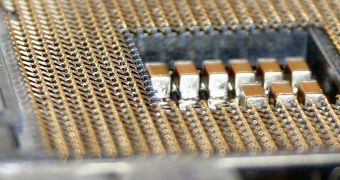We have been talking about Intel's family of next-gen processors, codenamed Nehalem. There are few things known for sure about the new family, and Intel is still reserved in giving firm details.
The great novelty in the Nehalems is the fact that they integrate the memory controller directly onto the processor die, which is not quite breaking news in the processor world, since AMD has already done this with their AMD's K8 and K10 core architecture. However, this architecture would greatly impact on the socket design. Unlike the main trend of increasing pin count for newer processors, Nehalem is known to sit on a simplified socket: the LGA715, also known as socket H. Intel will have to decrease the pin count, from the classic 775 to 715, since the memory controller is integrated in the processor, and additional signaling from the processor to the Northbridge will become redundant.
On the other side, the Japanese PC Watch magazine reveals that Nehalems would actually sit on a 1160-pin LGA1160 socket. Intel still keeps this issue mystified, neither denying, nor accepting the web-sphere speculations. Adoption of the LGA1366 socket would dramatically increase the number of pins, which would result in cross-CPU communication through the Intel QuickPath Interface (QPI). Again, this has been already smoked, as AMD did that long ago, when moving from PGA940 to LGA1207 on their server chipsets.
"We try to reduce the pin counts as much as possible to eliminate cross talk and other interference. But we do try to leave some pins for overhead and future use," sources inside Intel's labs say. The Nehalems are sure to use Intel's second-generation land grid array (LGA) design. This particular design is recognized by both AMD and Intel due to the ability to increase the pin density.
LGA1366 designs would be available for samples by the end of Q2 2008, but the LGA715 for desktops will enter mass manufacturing in the second half of 2008.

 14 DAY TRIAL //
14 DAY TRIAL //